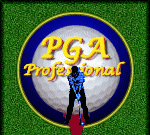Ask the Pro Archive - 2011
|
Here are all the golf questions and answers that appeared on the "Ask the Pro" page in 2011, from most recent to least recent, top to bottom. Links in the left menu column give a "keyword" indication
of the topic and will take you directly to that entry on this page. Also see the Ask the Pro Archive Index for longer descriptions in categorized and somewhat alphabetized form.
|
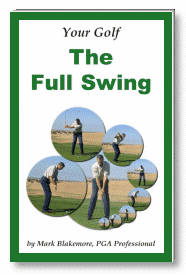 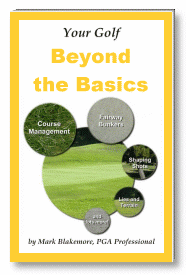 |
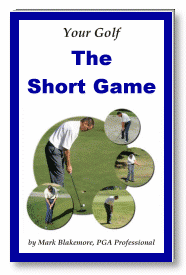 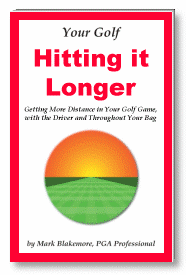 |
Question:
December 21, 2011
What is a flat swing?
Joe Albo
Monroe, NJ
Answer:
Hi Joe,
Flat and upright refer to the plane of the swing, or the arc that the club head describes in the swing (most easily observed from a down-the-line point of view). A flat swing is relatively more horizontal and an upright swing more vertical.
There is no such thing as one correct plane; it varies from club to club (e.g., longer clubs swing on flatter planes than shorter clubs) and from person to person (e.g., very generally, shorter or rounder players have flatter swings and taller, thinner players have more upright swings). Planes that are neither particularly flat nor upright might not be called anything at all, or might be considered neutral.
If you look at this entry in the Ask the Pro Archive you will see in the photo that 3 different planes are defined in the same address position with 3 different clubs. That might help to clarify it for you further.
Technique is covered in detail in my books "The Full Swing" and "Hitting it Longer." Thanks for visiting PGAProfessional.com and best of luck with your game. MB
Miscellaneous > Other > Swinging a weighted club
Question:
December 11, 2011
Is it a good idea to practice by swinging a heavy club?
Jim Todd
Vestavia Hills, AL
Answer:
I'm not a big fan of that for typical golfers, Jim. It's hard enough for most people to feel the club head without getting used to swinging something heavier. As a brief warm up, I might be able to see a rationale for it for people that are used to it and like to do it (if they already have good feel). But there are better ways to warm up. Thanks for visiting PGAProfessional.com and best of luck with your game. MB
Miscellaneous > Golf course-related > Hitting over water, effect on distance
Question:
November 22, 2011
My question is when hitting over water does it have an impact on distance? Take for instance playing two par 3's (say 165 yards) with one having grass from tee to green and the second having water from tee to green [, will it] have any impact ... on a balls flight or lift?
Allan Chambers
Calgary, Alberta, Canada
Answer:
Hi Allan,
I think a physicist or a meteorologist could give you a better answer to that question. I have heard -- anecdotally, from under-qualified people -- that a pond or lake creates a different barometric pressure, air temperature or humidity (or all of the above) above it than that which is above grass, etc., and that this causes the distance to play longer over water. I think it unlikely that a "body of water" of the size we are talking about on golf courses could actually have much of an effect. To me, it's more likely mental.
I'm perfectly willing to be proven wrong, however; I'm not claiming to actually know this for fact. I have never noticed the effect, myself, but I would tend to err on the side of caution and choose a longer rather than a shorter club when playing a shot across water anyway... though, that just seems like common sense more than anything else. Thanks for visiting PGAProfessional.com and best of luck with your game. MB
Miscellaneous > Professional golf-related > Senior tour shorter yardages than regular tour
Question:
November 6, 2011
Do the senior professional golfers hit from the same tees as ... the [regular] PGA [Tour]?
Tom Ware
Wichita, KS
Answer:
Hi Tom,
Overall the courses are somewhat shorter for the Senior Tours than for the regular PGA Tours, but the length of any given hole varies from day to day. Also see yardages for women and men professionals. Thanks for visiting PGAProfessional.com and best of luck with your game. MB
Long Game > General > Loss of body weight - effect on swing or distance
  |
  |
Question:
October 20, 2011
Can losing weight effect my golf swing? Distance?
Birdiey Thees
Stuart, FL
Answer:
Hi Birdiey,
Loss of body weight could indirectly effect your distance. But if it was a loss of distance I suspect it would be because of a loss of strength in general rather than just weight. If, on the other hand, it was an increase in distance I suspect that would be more a function of increased mobility rather than decreased weight, per se. It is possible that an extreme weight change could significantly alter the feeling (and therefore possibly also the mechanics) of your swing. There are many variables that could have an effect here. It would be best to have your swing assessed by a reputable professional -- ideally one who already is familiar with your game.
Technique is covered in detail in my books "The Full Swing" and "Hitting it Longer." Thanks for visiting PGAProfessional.com and best of luck with your game. MB
Miscellaneous > Other > Why to mark and replace very short putts
Question:
October 11, 2011
When a ball is hit close to the hole, why does a golfer pick up the ball, put a marker down, then immediately put the ball back down and putt?
Paul Dowsey
Silverhill, AL
Answer:
Hi Paul,
Usually it's just to make sure the ball is clean and there are no loose impediments under the ball, so that it will roll true—even on short putts. But other reasons could include plain old habit, consistency of routine, liking the ball lined up a certain way, etc. Thanks for visiting PGAProfessional.com and best of luck with your game. MB
Long Game > General > Which side to swing from, to play right or left-handed
Question:
September 20, 2011
My 3 year old son is r[ight]-h[anded] and swings a baseball bat [left]. Should I try to teach him to swing [left] or [right-handed]?
Ritchie Willoughby
Kenly, NC
Answer:
Hi Ritchie,
The most typical thing is to use whichever hand you use to throw as the low hand (i.e., throw right-handed, play golf right-handed), but there are exceptions. There may even be a component of eye dominance involved in the choice. But based on what I am aware of, I suspect that whichever side you play from if you stick with it and apply yourself you can develop as far as you are able. So it probably doesn't matter where you start.
Also see these related previous questions and answers in the archive - Swinging from non-dominant hand side decreasing distance? and Which hand dominates in the swing? and To emphasize the right hand or the left hand in the swing. Thanks for visiting PGAProfessional.com and best of luck with your game. MB
Rules, Etiquette and Procedures > How much time to play a stroke
Question:
September 4, 2011
...How much time can a player take to line up his ball and then make a putting stroke? We have a player in our group who looks at his putt from 50 different angles a[nd] it seems like he takes 5 minutes before he put[t]s his ball. It is very frustrating.
Tim Fram
Methuen, MA
Answer:
Hi Tim,
There is no rule about an exact amount of time, just that a player may not "unduly delay play" and that the time limits may be set by the committee of the competition. In the case of your casual play the "committee" would be your group as a whole, no? So if it bothers all of you try penalizing him in accordance with rule 6-7 and see how that goes over - heh heh heh. Also see rules questions. Thanks for visiting PGAProfessional.com and best of luck with your game. MB
Long Game > General > Benefits of a forward press
  |
  |
Question:
August 27, 2011
What are the benefits of a forward press before taking the club away? I'm looking for a "trigger" to get the swing started.
Peter McCurtayne
Iluka, New South Wales, Australia
Answer:
Hi Peter,
A forward press is as good a 'trigger' as any. All you're really looking for is something to get the movement going.
Some people do their forward presses with just the arms, while others use more of their whole body. There is really no right or wrong, as long as you can repeat it. But I would generally suggest keeping the movements small rather than large.
Technique is covered in detail in my books "The Full Swing" and "Hitting it Longer." Thanks for visiting PGAProfessional.com and best of luck with your game. MB
Miscellaneous > Other > Throwing up grass to gauge the wind
Question:
August 11, 2011
A lot of golfers throw grass up in the air just before they hit the ball. Since the ball is coming off the club face at 75 to 125 miles per hours, the practice seems irrelevant because of the speed of the ball... Or am I missing something?
Frank Sortin
Houston, TX
Answer:
Hi Frank,
The wind definitely has a huge impact on ball flight (though probably not much at the very beginning of the flight). What you really need, of course, is to know the exact wind speed and direction all along the trajectory of the shot in order to attempt to allow for it. But since you can't get that information you look at trees, flags, and you throw bits of grass up into the air to get a sense of the average wind speed and direction (at least in your immediate vicinity, in the case of throwing up the grass). That much information is better than nothing. In the end adjusting for wind is a guess based on experience and feel. Thanks for visiting PGAProfessional.com and best of luck with your game. MB
Long Game > General > Shaft planes vary from club to club
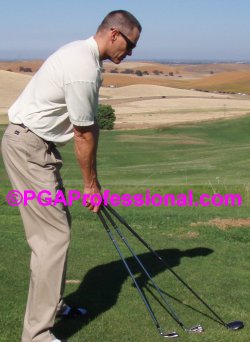 |
Question:
July 21, 2011
Practicing with instruction mirrors, I realized my shaft angle on my driver at address was quite different than my irons. Should all clubs have the same shaft angle?
Mike Kincaid
Tulsa, OK
Answer:
Hi Mike,
No, the length of the club dictates the plane: longer clubs flatter, shorter clubs more upright. The photo on the right shows the general idea. I'm holding a 8 iron, a 5 iron and a 3 wood.
If you are talking about the face-on view the answer would still be no: irons typically lean forward (toward the target) more than the driver. Thanks for visiting PGAProfessional.com and best of luck with your game. MB
Rules, Etiquette and Procedures > Not taking the flag out before removing ball from hole
Question:
July 7, 2011
I see it all the time that when a player holes out from the fairway or a hole in one the player will leave the flag in and reach down and remove the ball from the hole. Is there a reason or a rule that prevents them from taking the flag out of the hole?
Ken Gibson
Toronto, Ontario, Canada
Answer:
Hi Ken,
No, a ball is holed when all of it is below the top of the cup. But sometimes when you try to remove the flagstick with the ball in the hole it yanks the hole liner up and could damage the hole, so it's just safer to take the ball out first.
People also ask if there is a rule that specifies that you must remove the flag before removing the ball, and somehow that belief gets perpetuated. At this point I've heard it so many times that now I even seem to remember that many years ago there used to be a rule that said that if the ball came out of the hole when you removed the flagstick then it was not holed... But that's most likely the effect of repetitive suggestion, or a remnant from before my frontal cortex reached its full development, or from when I was accidentally in that parallel universe, etc., so you'll have to research the origin of that one yourself. Let me know if you find out anything interesting. Also see rules questions. Thanks for visiting PGAProfessional.com and best of luck with your game. MB
Long Game > Irons > To take a divot or not to take a divot - that is the question
  |
  |
Question:
June 28, 2011
Is it necessary to take a divot when swinging irons? I tend to sweep the ball and not take any divots.
Joseph Hubbs
Mt Royal, NJ
Answer:
Hi Joseph,
Helpful might be a better word than necessary for what you are getting at. At more advanced levels, better compression, more distance, finer control and the ability to make good contact from all surfaces is achievable by having the bottom of your swing in the right place and taking a divot with the irons.
That topic and the rest of technique is covered in detail in my books "The Full Swing" and "Hitting it Longer." Thanks for visiting PGAProfessional.com and best of luck with your game. MB
Equipment > Bulge and Roll with irons
Question:
June 10, 2011
If bulge and roll are required for the optimum functioning of the clubface of a wood, why are iron clubfaces flat?
Michael Goforth
Olympia, WA
Answer:
Hi Michael,
My understanding is that it is because the center of mass is much closer to the face in irons, so the effect of off center contact is not as dramatic. You could probably get a very detailed answer from a physicist or R & D guru at a club manufacturer. Thanks for visiting PGAProfessional.com and best of luck with your game. MB
Equipment > Breaking tees, why and how to stop
Question:
May 20, 2011
99.9% of the time I break my tee with my driver. Other peoples' tees seem to flip out of the ground. What do you think might be the problem?
Robert Crewse
Mountain View, MO
Answer:
Hi Robert,
I don't know of any studies on this. But I almost never break the tee when using a driver.
If the ground is very hard and the tee is pushed in very deeply, that will probably increase the chances of it breaking. What I do is wiggle it around a little bit so that it is not held rigidly by firm ground (but firm enough to not fall over). It is also more likely that the tee will break if the club brushes very low to the ground or comes down too steeply (rather than just clipping the top part of the tee with a shallow angle of approach, which is what happens when you make good contact -- also see this tip on hitting the driver).
I suppose it is also the case that some tees are made of heartier, or less brittle, wood than others. You might experiment with different brands or even alternate materials, like some of the plastic, nylon, bamboo, etc., tees. Thanks for visiting PGAProfessional.com and best of luck with your game. MB
Rules, Etiquette and Procedures > Playing a shot from a wrong green
Question:
May 11, 2011
If your shot happens to land on a green that is not the hole you are on, how do you go about playing your next shot? I don't think using an iron would be permitted on a green at any time.
Steve Wylie
Sudbury, Ontario, Canada
Answer:
Hi Steve,
I normally don't answer rules questions that are easily found in the rules or decisions books, as this one is (see rules questions). But this information will help keep courses in better shape, so...
No, you must not play from a wrong green. It's a free drop, nearest point of relief, no closer to the hole (get completely clear of the green with your stance too, as the action of your feet may tear up the fragile green surface to some degree also).
As a point of interest, see this previous Q & A about pitching from on the green. Thanks for visiting PGAProfessional.com and best of luck with your game. MB
Miscellaneous > Professional golf-related > How tournament announcers know what club players are using
Question:
April 28, 2011
How do the tournament commentators determine what club players are using on their shots?
Charlie Smith
Tampa, FL
Answer:
Hi Charlie,
Typically the caddies signal the on-course commentators. Thanks for visiting PGAProfessional.com and best of luck with your game. MB
Miscellaneous > Golf course-related > How course rating and slope are determined
Question:
April 14, 2011
What determines the slope and rating of a golf course?
Joseph Dumas
Tampa, FL
Answer:
Hi Joseph,
A rating team from the local branch of the USGA (e.g., state golf association) visits a course to play and evaluate how difficult it is for scratch golfers (course rating), how difficult it is for bogey golfers (bogey rating), and the difference between those (slope), based generally on how long the golf course plays and its navigability (i.e., how tough the hazards and greens are, how narrow the fairways are, etc.). Thanks for visiting PGAProfessional.com and best of luck with your game. MB
Miscellaneous > Golf course-related > "Front" edge of bunker
Question:
March 21, 2011
Is the front edge of a bunker the edge closest to the tee or to the green?
B. Smith
Augusta, GA
Answer:
It's probably easiest to think of it in terms of where you are playing from. If you're just talking about the general layout of a golf hole, from tee to green, the "front" edge of a bunker would be the edge closest to the tee, or the first edge of the bunker that you would normally come to, or cross, when proceeding from the tee. But if you were beyond the green playing back toward the tee and had to cross a bunker, the front edge of that bunker would be the closest edge to you. So for greenside bunkers think of the front edge as being the farthest edge from the green and the back edge as being the closest edge to the green on any given angle of approach.
Thanks for visiting PGAProfessional.com and best of luck with your game. MB
Equipment > Goggles to protect eyes from sand
Question:
March 1, 2011
Why aren't goggles worn when you are in a sand trap and you know sand is going in your face and eyes after the shot?
Douglas Wallace
Washington, DC
Answer:
Great idea, Douglas! I wish I would have thought of that a long time ago. Sunglasses or regular eye glasses would pretty much do it, too. But actual goggles that are sealed around the edges would be perfect. Maybe a trend will start. Thanks for visiting PGAProfessional.com and best of luck with your game. MB
Long Game > General > Choking down for more distance
  |
  |
Question:
February 23, 2011
Another player told me that in order to get more head speed to make the ball go farther I need to choke down on the club. Is this right?
David Lott
Calimesa, CA
Answer:
Hi David,
All else being equal, shortening the radius of the swing arc ("choking down" on the club -- also strangely referred to as "choking up", go figure*) would decrease club head speed rather than increase it. But in the real world of human beings and their golf swings, choking up does seem to have the effect of improving the quality of contact, on average, thus creating longer average distance overall.
I'm sure it's too much to assume that this is true in all cases: it may not be the case for all highly skilled players or for all people with relatively consistent swings and good feel. You'll have to experiment a bit to see how it applies to you.
Technique is covered in detail in my books The Full Swing, The Short Game, Beyond the Basics and Hitting it Longer. Thanks for visiting PGAProfessional.com and best of luck with your game. MB
* Also see my article on ambiguous golf terminology
Rules, Etiquette and Procedures > CSS - Huh?
Question:
February 13, 2011
We play one competition over two days[.] Can I set a CSS for the whole of the comp[etition] or does it have to be two seperate CSS[?]
Barry Lee
Liverpool, Merseyside, U.K
Answer:
Hi Barry,
Until now I had never heard of "CSS" in that sense. Being from the U.S., the acronym CSS only stands for Cascading Style Sheets (a language for formatting text and other elements of web pages, etc.), as far as I knew.
It sounds like CSS in the U.K. is somewhat like course rating or slope here in the U.S. I would recommend that you direct this question to the handicapping organization from where you are, CONGU.
If you let me know what you find out I will post the information so that others can find it. Thanks for visiting PGAProfessional.com and best of luck with your game. MB
Miscellaneous > Golf course-related > Estimating yardage when off center
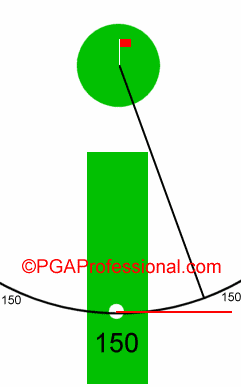 |
Question:
January 22, 2011
How do you accurately estimate yardage distance when you have a shot that's off the fairway to the side?
Rick Harkness
Canton, MI
Answer:
Hi Rick,
Most quality courses nowadays will have yardage markers located all over the place, not just in the center. The best way to get your yardage is to pace from the closest marker you can find -- and know how to step one yard reasonably well-- or use some kind of a reliable range finder device (if your situation allows).
But if there are only markers in the center, you can see from the image on the right that as you get farther to the side you get a bit farther away. In most cases the amount is negligible, so unless you have very precise control over your distances guesstimating is probably close enough. As you go through the trial and error process your ability to do this (feel) will improve. Thanks for visiting PGAProfessional.com and best of luck with your game. MB
Miscellaneous > Golf course-related > Par 6's?
Question:
January 11, 2011
Are there any golf courses with par 6's and if so do you know how many?
Ron Cerjan
Concord, OH
Answer:
Hi Ron,
Yes, absolutely, but I don't know how many. It would not surprise me to learn that there were quite a few, but it is still rare. Thanks for visiting PGAProfessional.com and best of luck with your game. MB
